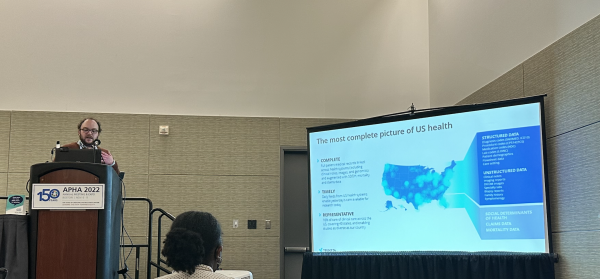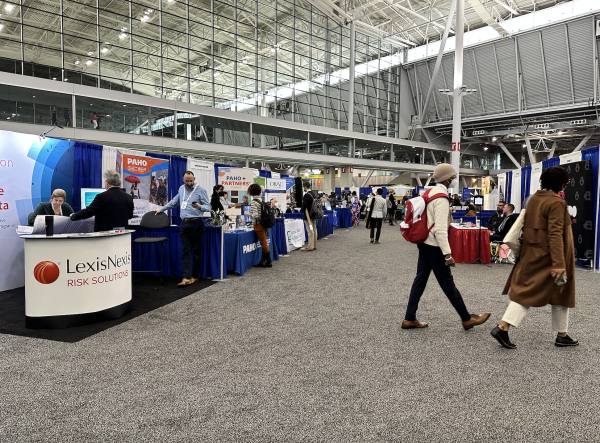Last week, two members of Truveta Research — Dr. Charlotte Baker, DrPH, MPH, CPH, and Dr. Peter Smits, PhD — attended the 150th Annual Meeting of the American Public Health Association (APHA) in Boston.
Dr. Peter Smits presented on Truveta Research’s methods and findings on the risks of breakthrough COVID-19 infection among vaccinated individuals, and the chance of hospitalization following that breakthrough infection, focused on differences in risk associated with four common comorbidities:
Background: Studies have shown that those with certain high-risk comorbidities such as diabetes, chronic kidney disease (CKD), chronic lung disease, or those with immunocompromising conditions, have increased risk of hospitalization from COVID-19. Here we estimate the elevated risks of breakthrough infection and hospitalization in fully vaccinated individuals with comorbidities.
Results: Of over 3.4 million fully vaccinated patients, 2.8%, 2.6%, 2.4%, 1.8% with CKD, chronic lung disease, diabetes, and those in an immunocompromised state experienced breakthrough infection, respectively, compared to 1.95% in the overall population All comorbidities were associated with significantly increased odds of breakthrough infections and subsequent population. All comorbidities were associated with significantly increased odds of breakthrough infections and subsequent hospitalizations. Breakthrough infection hospitalizations in populations with comorbidities ranged from 26% for CKD to 10% for chronic lung disease, with corresponding ORs of 2.22 (95% CI: 1.88 – 2.63) and 1.37 (95% CI: 1.21 – 1.55), respectively.Conclusions: Fully vaccinated individuals with certain comorbidities experienced increased risk of breakthrough COVID-19 infection and subsequent hospitalizations compared to the general population. Individuals with comorbidities should remain vigilant against infection even if vaccinated.
You can read the preprint of this article in medRxiv.

Dr. Peter Smits presenting at APHA.
This was Peter’s first year at APHA, and after showcasing Truveta’s capabilities, and introducing the new Truveta Studio, he was approached by multiple researchers who work with state health agencies and other healthcare data consortiums. “I had never been to APHA before,” Peter said. “We’re so glad to meet people who are interested in our data and the unique opportunities we present when discussing public health and disease monitoring. I heard some great talks that highlighted the difficulty public health researchers have with obtaining high quality and timely data at fine spatial scales. I enjoyed my first time and hope to go again.”
Dr. Charlotte Baker co-presented with two of her students from last year at Virginia Tech. Here are some of the details from those presentations:
Characterizing use and distribution of crizanlizumab among patients with sickle cell disease: A retrospective descriptive comparison – Miles Thomas, BS1, Mandy Atkinson, MD2, Charlotte Baker, DrPH, MPH, CPH3 (1)Virginia Tech Carilion School of Medicine, (2)Carilion Clinic Pediatric Hematology & Oncology, (3)Virginia-Maryland College of Veterinary Medicine at Virginia Tech
Background: Crizanlizumab was approved in 2019 for the reduction of vaso-occlusive crises in sickle cell disease (SCD). Little information is available about how crizanlizumab is being deployed or what considerations dictate its use. Understanding this further may give physicians better insight into how this medication is being implemented. Discussion: Our results indicate that among patients who are eligible for crizanlizumab, a small proportion have received it. The reasons for this could be many, including cost, medication awareness and social determinants of health that may limit patient access. We intend to further explore these factors and invite others to do the same.
The other presentation studied historically redlined communities in the US:
How has social vulnerability changed in the past two decades in historically redlined neighborhoods? – Oluwatosin Ogunmayowa, Dr. Charlotte Baker, Virginia Tech
Background: Assessment of change in neighborhood social vulnerability (SVI) is important in understanding the effectiveness of public health policy interventions; however, we do not know if SVI has changed in neighborhoods that were historically redlined in the US. In this study, we assessed whether SVI has changed in the past two decades in the US, (2) SVI change over time differ in redlined versus non-redlined neighborhoods, and (3) SVI change over time differ by US region. Conclusion: This study indicates that neighborhood social vulnerability has improved over time in the US, however, not all regions have seen improvements in vulnerability over time.

The APHA conference & vendor booths.
“I’ve been a member of APHA since 2008,” Charlotte said. “The conference marked the end of my term as the Chair of the Injury Control and Emergency Health Services section of APHA. There was a large social determinants and social justice vibe to the conference including a coinciding women’s rights/pro-abortion rights march, a member-led emphasis to protect attendees through a vaccine and mask requirement, and so many neat sessions about incorporating social determinants into every aspect of work. I’m always excited to reconnect with colleagues around the world at this conference and see how much changes year to year.”
We hope to connect with more researchers and members of the healthcare industry at APHA in the future!
For more on Truveta’s research, news, and technology, follow us on LinkedIn and sign up for our newsletter below.
